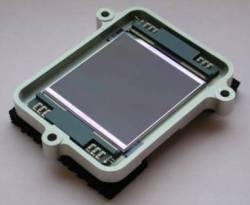Feb 11 2010
On February 10th 2010, six e2v Charge Coupled Device (CCD) imaging sensors are launching into space from Cape Canaveral, Florida on board NASA’s Solar Dynamics Observatory (SDO), the first of NASA’s Living With a Star (LWS) programs to launch. The programs have been designed to study and understand the causes of solar variability and the impact these have on Earth and Near-Earth space.
 SDO imaging device - e2v CCD203-82
SDO imaging device - e2v CCD203-82
The SDO spacecraft has been designed to examine the evolution of solar activity and to refine our understanding of space weather by studying the Sun on small scales of space and time and in many wavelengths simultaneously. To do this, SDO has three scientific instruments on board; the Atmospheric Imaging Assembly (AIA), the EUV Variability Experiment (EVE) and the Helioseismic and Magnetic Imager (HMI). e2v imaging sensors were supplied for the HMI and AIA instruments which were both built by the Lockheed Martin Solar and Astrophysics Laboratory (LMSAL).
Four specially processed back illuminated e2v CCD203-82 (4k x 4k) sensors sensitive to extreme UV wavelengths are incorporated into the four AIA telescopes which will observe the Sun in wavelength range 9.4nm to 170nm. The AIA instrument is under the direction of Dr. Alan Title at LMSAL, and will use solar images taken in multiple wavelengths to study the energetics of the solar atmosphere and it’s interaction with the surface magnetic fields.
Two front illuminated e2v CCD203-82 (4k x 4k) sensors are used in the HMI instrument to image the Sun in visible light at 617nm. The HMI instrument (built by LMSAL) is under the direction of Prof. Philip Scherrer at Stanford University, and will measure both solar surface magnetic fields and the Sun’s surface motion as a probe of the solar interior.
Though the performance was optimised for each instrument, all CCDs have the same electrical format and were designed to operate at lower voltages than normal. This facilitates provision of drive electronics and also reduces the power demand on the spacecraft. The camera electronics were built in the UK by e2v’s project partners at the Rutherford Appleton Laboratory.
Jon Kemp, General Manager of Space and Defence Imaging at e2v said “e2v is proud to have partnered with Lockheed Martin and Stanford University in this cutting edge endeavour to advance human-kind’s knowledge of our environment. The e2v sensors will deliver high performance to enable what we are sure will be another successful mission. The launch of SDO marks the 3rd time in recent months that e2v sensors have contributed to US space programmes, following Kepler and the Hubble upgrade.”